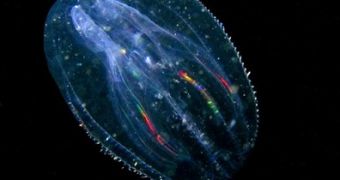The North American comb jellyfish Mnemiopsis leidyi is able to feed on the world's most vigilant zooplankton, and a team of researchers including one from the University of Gothenburg, managed to understand its strategy.
This jellyfish, recently established in Northern Europe, eats large quantities of zooplankton, thanks to its ability of being hydrodynamically invisible.
Mnemiopsis leidyi feeds on copepod plankton, which is known to have one of the fastest escape responses, and this is actually what led the researchers to want to investigate this stealth mechanism.
Lars Johan Hansson, a researcher at the Department of Marine Ecology at the University of Gothenburg says that “copepods have a well developed ability to detect even the slightest water disturbance.
“They can swim well clear of the source of water deformation in just a split second, [and] how the comb jellyfish is able to approach and catch some of the animal world’s most vigilant plankton has up until now been unknown.”
For this research, the scientists used an advanced video technology and recorded the water flows around and within the jellyfish, AlphaGalileo reports.
Then they calculated the water deformation caused by the jellyfish, and compared it to the levels that triggered the escape response in copepods.
The jellyfish is way smarter: “it uses microscopic, hairlike cilia inside its oral lobes to generate a feeding current that carefully transports water between the lobes.
“As the water accelerates slowly and is transported undisturbed into the jellyfish together with the prey, there is nothing that alarms the prey until it is next to the capture site inside the lobes, by which time it’s too late to escape.
“This makes the jellyfish a hydrodynamically silent predator,” said the researcher.
This innovating research was carried out by a joint team, including members from the USA, Norway and the Department of Marine Ecology at the University of Gothenburg.
The study – Stealth predation and the predatory success of the invasive ctenophore Mnemiopsis leidyi – has been published in the scientific journal PNAS, and it is also mentioned in this week’s issue of Nature.

 14 DAY TRIAL //
14 DAY TRIAL //